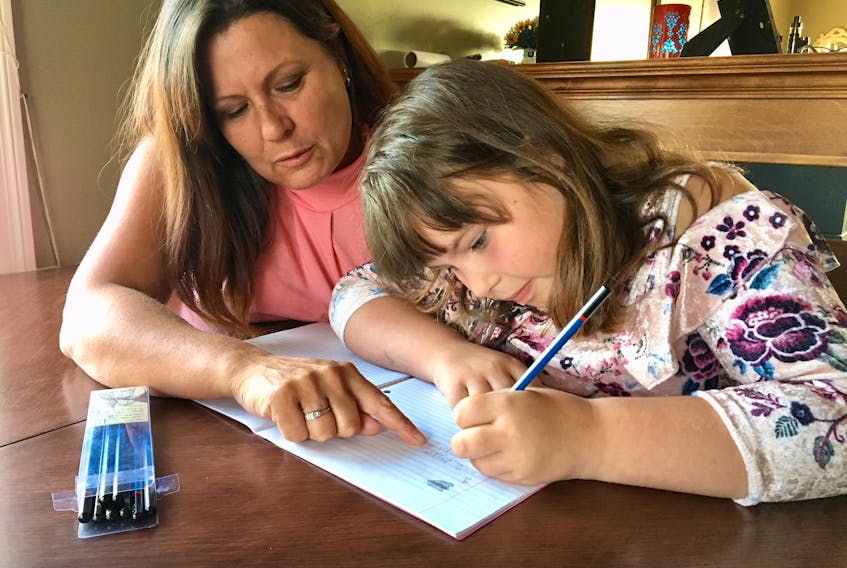After eating supper at a local restaurant, a group of customers heads to the cash to pay for their meal.
One of them hands the 18-year-old woman behind the counter their bill, which included their waitress’s neatly handwritten list of their food order.
With a puzzled look, the teenager stares at the piece of paper until she finally says, “I’m sorry, I can’t make this out. I’ll have to get your waitress.”
Confused, the customer asks why she couldn’t make out such legible notes.
“It’s in (hand)writing,” the young woman replies. “I can’t read writing. We didn’t do it in school.”

It’s not a rare occurrence.
The restaurant employee is one of many young people in this province who are finishing high school in Newfoundland and Labrador without the knowledge of cursive writing.
It’s because cursive writing instruction is no longer emphasized in schools. Gone are the days when students had designated writing classes, in which they used workbooks with dotted lines to practise forming the perfect loops for Ls and Ys under the watchful eye of their teacher.
In an age of technology in which this generation seems to only require keyboard and texting abilities, cursive writing, it seems, has gone the way of cassette tapes.
The days of pen pals are long behind us, as texting and computer messaging have taken over.
Lots of debate
It’s sparked much debate.
Some believe cursive writing is no longer a necessary skill and wastes valuable teaching time.
"I teach Lexie how to write myself, but a few people I know think it’s a waste of time. I don’t think it’s a waste of time. I think it will be useful for her and I can’t believe the schools don’t teach it anymore.”
Shilo Stagg
That’s disappointed others who believe it’s an essential part of childhood education, and that taking focus away from instruction puts our children at a disadvantage in a world where there are still so many cursive writers and so much cursive-written material.
“It’s ridiculous,” said Shilo Stagg, whose eight-year-old daughter Lexie attends Grade 3 at Octagon Pond Elementary. “I teach Lexie how to write myself, but a few people I know think it’s a waste of time. I don’t think it’s a waste of time. I think it will be useful for her and I can’t believe the schools don’t teach it anymore.”
According to the province’s Department of Education, cursive writing instruction was never a mandatory part of the English Language Arts curriculum in this province.
“The Department of Education (and Early Childhood Development) never, ever authorized a resource for the teaching of cursive writing,” assistant deputy minister Elizabeth Churchill said. The instruction students received in previous years was school-driven and was often a focus of teachers.
“So, if a school did it, they did it based on their own school development plan of writing and they ordered the resource.”

Legibility a main focus
Currently, cursive writing is one of the “suggested” ways to publish and share writing at the Grade 3 level, according to the department.
“The focus is not on one’s ability to write in a prescribed, cursive manner, but rather on legibility,” Churchill said.
“It is acceptable if a student prefers to use printing rather than cursive writing as a legible form of penmanship. Students who experience difficulties with manual dexterity may be supported with assistive technology devices.”
Many agree wholeheartedly with that logic.
But that doesn’t sit well with some other people who feel young people are being shortchanged by not being taught the skill.
Kids can’t sign their name
“It’s a tragedy,” retired teacher Philip (Bud) Thorne said of the loss of cursive writing instruction in schools.
Thorne hasn’t been in a school classroom since 1996, but runs Behind the Wheel Driving School in St. John’s and has seen first-hand the effects of cursive writing having been eliminated in the school system.
“When the kids get their licence and go to motor vehicle registration to get their photos taken, they can’t even sign their name. Can’t sign their name!” he said.
“It makes me sick!”
Thorne understands typing is the more common means of communicating these days, but believes cursive writing plays an important role as well.
“It’s a lost art,” said Thorne, who taught for 30 years at Gonzaga and Holy Heart high schools in St. John’s.
“Maybe it’s one of those things where I’m so old-fashioned, but I still believe kids should know how to (hand)write. … Handwriting is everywhere in the world today and is still valuable.”
It’s an opinion that’s shared by many provinces in this country.
This province is one of the few in Canada where cursive writing is not a mandatory part of the curriculum.
In response to The Telegram’s request, every province responded.
Newfoundland and Labrador is one of three provinces in which instruction in cursive writing is introduced to children, but is not mandatory. British Columbia and Ontario are the other two.
Seven other provinces — Alberta, Saskatchewan, Manitoba, Quebec, New Brunswick, Nova Scotia and Prince Edward Island — have cursive writing instruction as a mandatory requirement in their curricula, usually in Grades 3 to 6.
• “The emphasis is on learning to print and write clearly and legibly rather than on any specific style of handwriting, such as cursive.
“If teachers wish to teach children to use the cursive writing style, they are welcome to do so and there is nothing in the curriculum that would prevent this from occurring…. but cursive style is not a requirement.”
Director of communications Corinna Filion, British Columbia
• “While the curriculum does not include cursive writing as a mandatory learning expectation, cursive writing is included as an example of how a learning expectation in achieved.”
Media relations specialist Ingrid Anderson, Ontario
Many of the responses pointed out that other methods of communication, such as printing and multimedia, are available to students, depending on each student’s needs.
Nova Scotia’s Fairbairn wrote, “Recognizing the individual needs of students, teachers then work directly with their students to determine how writing outcomes are best achieved.”
Some noted that while there’s cursive writing instruction in earlier grades, students have the choice in later grades.
“In Grade 4, teachers are encouraged to continue focusing on cursive writing. After that, students can choose the script they prefer,” New Brunswick’s Mallet-Chiasson said.
[email protected]
Twitter: TelyRosie
QUICK FACTS
Here’s what other provinces say about cursive writing in their school curriculums:
• “Cursive writing is a learning expectation. … Learning cursive writing allows one to understand a text written in cursive writing and be understood by others using this same skill… Note-taking, reading and understanding primary sources or documents in history are examples of where it is beneficial to understand and use cursive writing.”
Public affairs specialist Julie Devoin, Manitoba
• “As part of an effective (Grades 3 and 4) English Language Arts program, students are expected to form letters and numbers correctly and with ease in cursive writing. Additionally, the ministry describes handwriting as a basic communication skill for middle years students.”
Sector relations consultant Matthew Glover, Saskatchewan
• “The ability to read cursive is still important in today’s world,”
Communications officer Genevieve Mallet-Chiasson, New Brunswick
• “Cursive writing is part of Alberta’s curriculum as part of our commitment to ensure students master fundamentals, such as comprehension of texts and communication in a variety of forms. … Cursive writing will remain an important part of our educational outcomes.”
Press secretary Lindsay Harvey, Alberta
• “Both writing styles (cursive and script) must be taught. Schools have the freedom to decide which style to favour according to the student’s grade level. Students have until Grade 4 to learn script and cursive writing.”
Media relations officer Bryan St-Louis, Que.
• “Students learn to effectively communicate using a range of methods, such as printing, cursive writing and multi-media.”
Media relations adviser Heather Fairbairn, Nova Scotia
• “Instruction in cursive writing begins in Grade 3. Instruction and practice continue in Grade 4 and are reinforced and practised in Grades 5 and 6 in order for automaticity to occur.”
Senior communications officer Jean Doherty, P.E.I.









